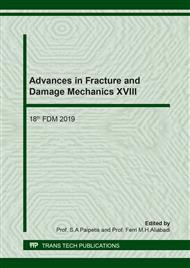p.159
p.165
p.171
p.178
p.184
p.190
p.196
p.203
p.209
Effect of Air Oxidation Treatment of CNT on Tensile Strength of CNT / Polyamide 6 Nanofibres and their Dispersion
Abstract:
Carbon nanotube (CNT) is excellent in mechanical and thermal characteristics, and are expected to be used in various fields such as nanoelectronic devices and reinforcing nanofillers for composites. It is expected that mechanical properties can be improved by adding CNT into the polymer. However, since CNT exists in a state of aggregation due to van der Waals forces, it is necessary to uniformly disperse CNT in order to fully extract the properties of CNT. In this study, CNT/polyamide 6 (PA6) composite nanofibres were fabricated by the electrospinning method. In order to disperse CNT in the CNT/PA6 nanofibres, CNT were subjected to air oxidation treatment. As a result of evaluating the dispersibility of CNT by sedimentation test, the dispersibility in pure water and HFIP is improved by oxidizing the surface of CNT. By conducting tensile tests and SEM observation of the nanofibre non-woven fabric, the influence of the surface treatment on the tensile strength of CNT/PA6 nanofibres and the dispersion of CNT was clarified. Although the addition of untreated CNT to PA6 nanofibres reduces the displacement at break, air oxidized CNT/PA6 suppressed the formation of CNT aggregates, and showed higher tensile strength and larger displacement at break than untreated CNT/PA6.
Info:
Periodical:
Pages:
184-189
Citation:
Online since:
December 2019
Authors:
Keywords:
Price:
Сopyright:
© 2020 Trans Tech Publications Ltd. All Rights Reserved
Share:
Citation:


